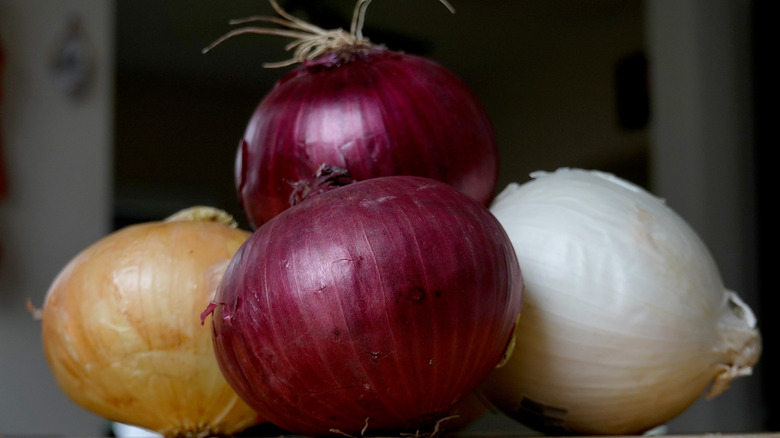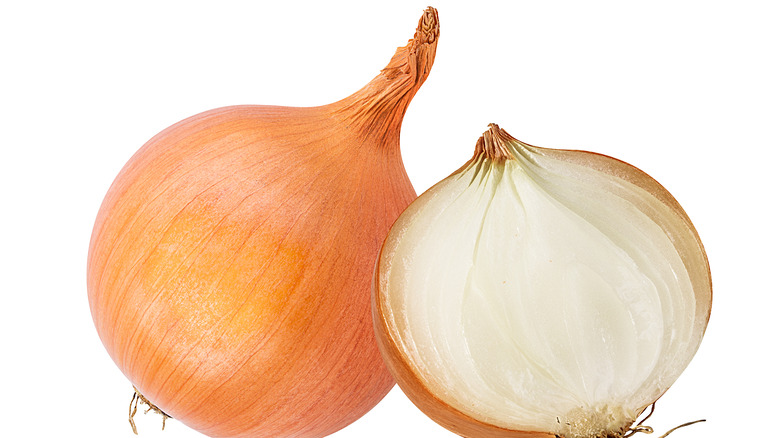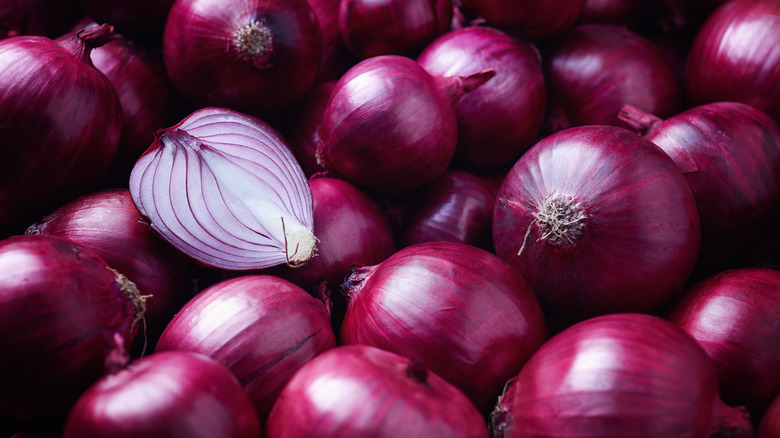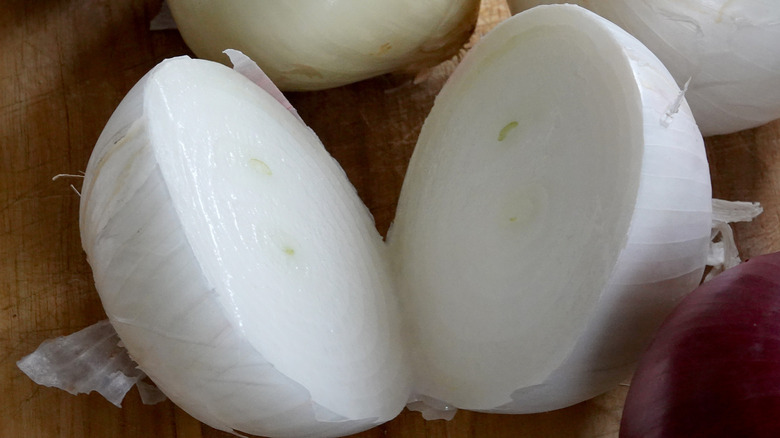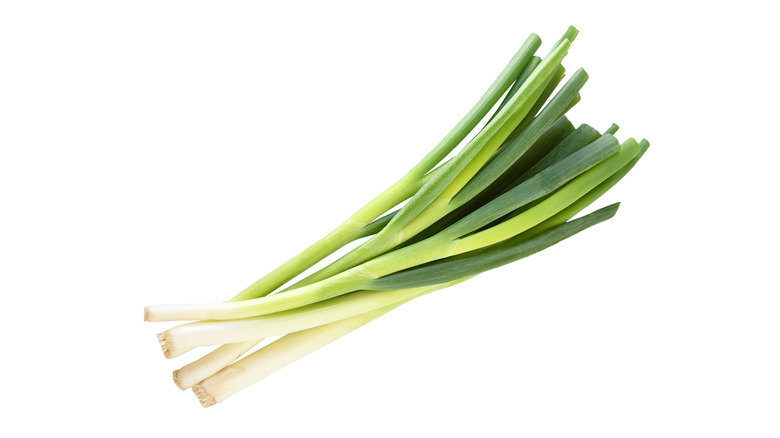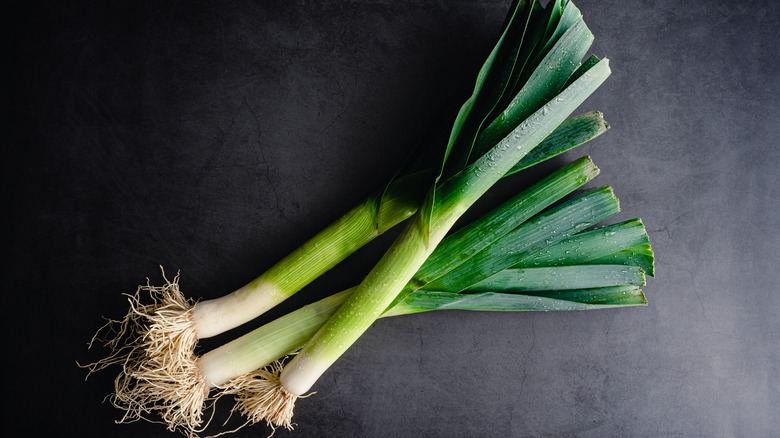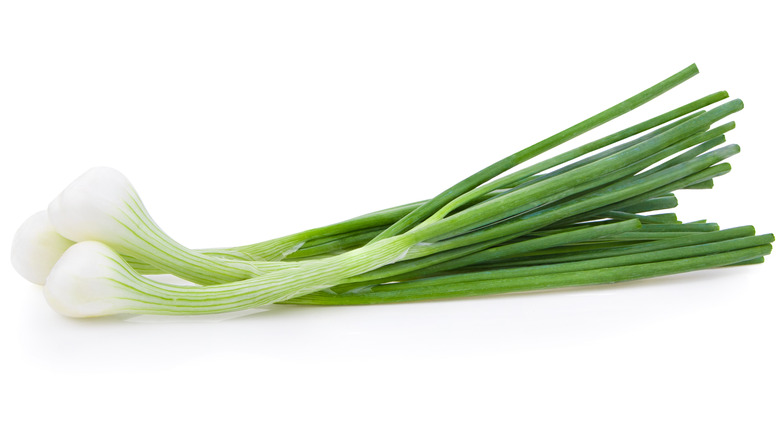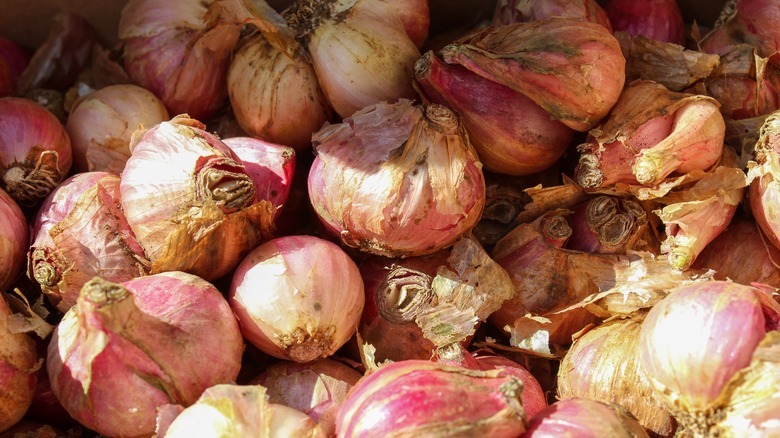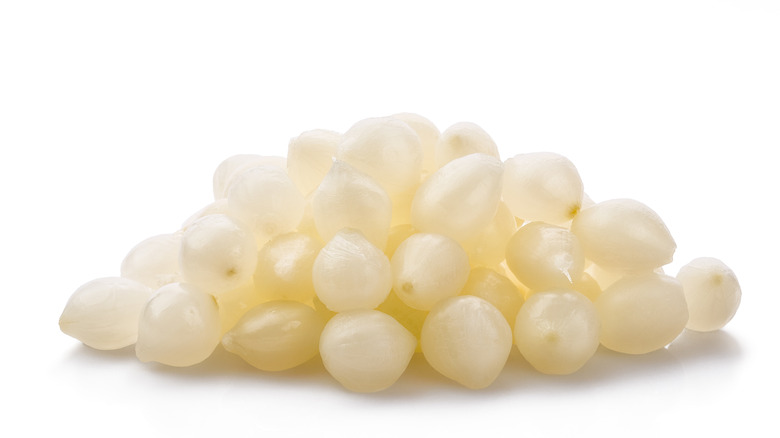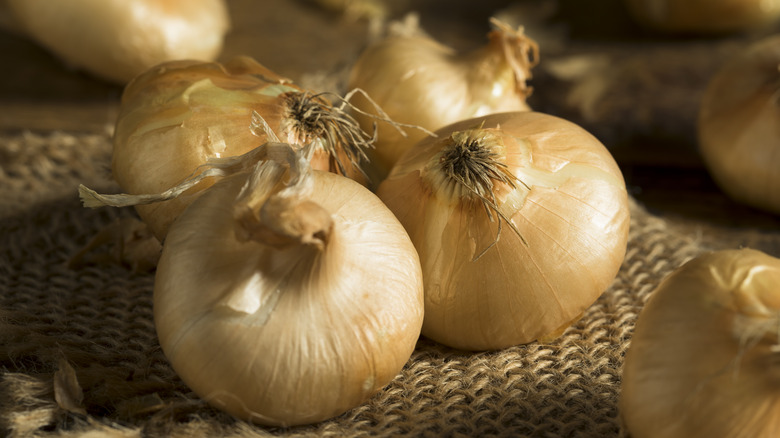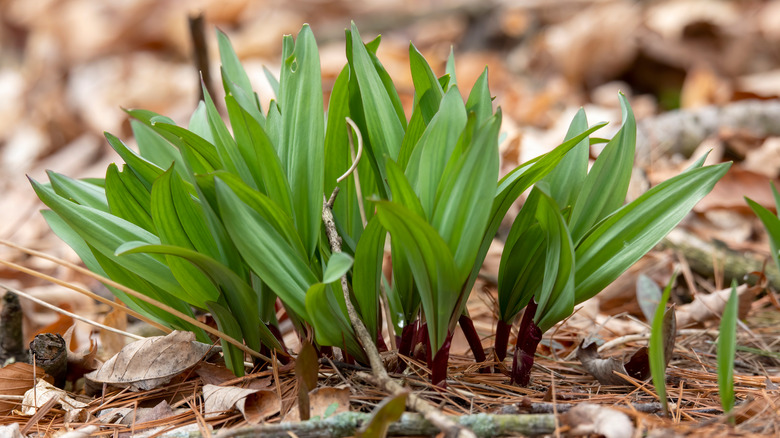The Most Popular Types Of Onions Explained
The onion is one of the basic building blocks of good food. Innumerable recipes use onions as part of the foundation of their flavor, and sautéing some onions in hot fat is a surefire way to make your kitchen smell amazing.
The versatility of the humble onion is hard for any other ingredient to match. Depending on how you treat them, onions can be sharp and pungent, sweet and sugary, or simply savory. But it's not just how you cook them, either; there are many different types of onions, and each one brings its special attributes to a dish. You could say that, like ogres, onions have layers.
If you've ever been overwhelmed by the onion selection at your local grocery store or thought to yourself, "what even is a shallot, anyway?" this guide is for you. We break down the most popular types of onions (and onion-like alliums), tell you what they taste like, and briefly explain what applications they're best for.
Yellow onion
The three most common types of onions — the ones that grow as large bulbs and come in yellow, white, and red varieties — are all known as storage onions. That's because, as their name suggests, they don't go bad quickly and are available year-round. Of these three, the yellow onion is the workhorse. The vast majority of U.S. onions are yellow, and they're what you should reach for when a recipe simply asks for "an onion" (via MasterClass).
Yellow onions are incredibly flavorful. They have a high sugar content and are high in sulfur, so they're both sweet and pungent. The pungency abates as you cook them, leaving behind the sweetness. However, when raw, they taste quite sharp, and you may find that you prefer other types of onions for raw applications.
You might see yellow onions labeled as "Spanish onions" occasionally. Spanish onions tend to be a little sweeter and less astringent than normal yellow onions.
Red onion
Red onions are similar to their yellow cousins in size, shape, and flavor, but they're a deep reddish-purple instead of pale yellow. You may find that they taste a little less sharp when raw than yellow onions do, and chefs and consumers alike tend to prefer them for raw applications like sandwiches and salads (via Specialty Produce). You can also pickle them, which gives them a beautiful pink hue and makes them a perfect topping for a variety of dishes like salads, burgers, and tacos.
According to the National Library of Medicine, red onions are purple because they contain anthocyanins, which, in addition to being pigments, are antioxidants that can be beneficial to your health. If you're wondering why they're called red onions when they're purple, Allrecipes posits a few different possible explanations. It could be that the name developed before we had many names for colors when the word "red" had a broader definition than it does today. Another potential source of the name is that red onions can be used to make red dye. But perhaps the simplest answer is that some red onions are red, as their color varies depending on growing conditions.
White onion
As we have previously noted, white onions are the mildest of the three common storage onions. White onions are perfect for eating raw because they have more water in their flesh, which gives them a crunchier bite than other onion varieties, according to MasterClass. This makes them great for a variety of recipes like salads, sandwiches, pico de gallo, and guacamole (dreaming of Chiptole now). They can also be cooked and used like any other onion, though their flavor will be a little muted compared to yellow or red onions.
Aáron Sánchez insists that they are the only proper onion to use as a topping for tacos, and we can't argue with that.
Whether raw or cooked, white onions are indispensable in Mexican food. They are the favorite onion in most parts of that country, except for the Yucatan, where red onions are preferred (via MexConnect).
Sweet onion
The term "sweet onion" is a catch-all for several different regional onion varieties, including Georgia's Vidalia and Hawaii's Maui. The trait they all share is that they are low in sulfur, which is the compound that makes standard onion varieties pungent. Per Fine Cooking, the lack of sulfur is due to the soil conditions in the regions where they are grown.
Sweet onions are more delicate and have a shorter shelf life than storage onions. For that reason, they are traditionally only available for part of the year, though that is changing. Most varieties are harvested in the spring or summer.
Sweet onions are great for raw onion garnishes, as they lack the astringency of other types of onions. They also respond well to cooking methods that enhance their inherent sweetness. If you want a dish that treats sweet onion as a centerpiece, try making an onion sandwich with raw slices of sweet onion on some bread lathered with your favorite condiments.
Scallion
Scallions, also known as green onions, are long and thin cylinder-shaped onions that taste somewhat similar to bulb onions, though a little less intense (via The Kitchn). Scallions have two distinct parts: the dark green tops and the white bases. Each part of a scallion is good for different uses. Per Bon Appétit, the tender tops are perfect for adding to food at the last second as a garnish. The white parts, which have a more intense flavor, are great for cooking.
In Chinese cuisine, scallions are the default onion used for cooking, according to The Woks of Life. Scallions form part of the flavor base of a high percentage of Chinese dishes. While bulb onions are occasionally used in Chinese food; they're known as "Western onions" and are far less common than scallions. Scallions don't keep as long as standard onions, so if you struggle with them going bad, check out our tips for keeping scallions fresh.
Leek
Okay, leeks aren't technically onions, but they're an allium with an oniony flavor, so we think they belong in this article (via MasterClass). They taste similar to regular bulb onions, but they're milder, sweeter, and less pungent. Leeks kind of resemble overgrown scallions, with dark green tops fading into white stalks. The top leaves are often thrown out, as they're quite tough and fibrous. However, with some careful cooking, they can be transformed into something tasty, as both The Guardian and Taste point out.
The white and light green parts of a leek are quite versatile. You can use them as a flavoring component of various dishes or serve them as a vegetable in their own right. One thing to pay attention to when preparing leeks, though, is that they're usually filled with dirt when you buy them, which leads to an unpleasant eating experience if they're not properly cleaned. Read our guide on how to clean leeks to make sure you don't actually serve any sand.
Spring onion
You might think spring onions are the same thing as scallions, and you're kind of right: In some countries, scallions are often called spring onions (via The Kitchn). However, true spring onions are actually quite different from scallions. They both have the same general shape with a green top and a white base, but, in spring onions, the base flares out into a miniature onion bulb. You can almost think of them as a hybrid between regular onions and scallions. They got their name because, traditionally, they're harvested in the spring.
The green part of a spring onion will usually taste spicier than the equivalent part of a scallion. The bulb end, conversely, tastes sweet, especially when cooked. You can chop it up and use it any way you'd use a normal yellow onion, but if you want to highlight what makes spring onions special, try throwing them on the grill. This recipe for grilled spring onions with romesco is a traditional and delicious way to celebrate this ingredient.
Shallot
Shallots aren't exactly onions, but, per Bon Appétit, they're in the same family. They taste similar to onions and can be used as a substitute in most recipes, although they bring their own special flavor to the party. They look a lot like small red onions, though they're shaped slightly different and they come bunched together in a manner that's more reminiscent of garlic.
Taste-wise, shallots are like sweeter, gentler onions. They're great for when you want that onion-esque flavor in a dish but don't want the sharpness of onions to overwhelm the other ingredients. For example, our shallot mignonette recipe adds just the right amount of brightness to raw oysters without upstaging the star of the show. If you made it with regular yellow onion, it might distract from the delicate flavor of the shellfish.
Shallots are also great in cooked applications. Since they're relatively small, they can even be cooked whole, which enhances their sweetness.
Pearl onion
Pearl onions are the same as normal bulb onions, except they're grown in a way that prevents them from developing to full size, (via Fine Cooking). Just like full-size onions, you can find white, yellow, and red varieties.
They taste like regular onions, so you could theoretically use them in any recipe that calls for onions, but most pearl onion applications take advantage of their diminutive size by leaving them whole. One popular way to use them is to pickle them. If you garnish a classic martini with pickled pearl onions instead of olives, it becomes a Gibson, according to Liquor.com.
The main challenge you will face when working with pearl onions is peeling them. Peeling normal onions is already a hassle, so you can imagine how annoying peeling many tiny onions can be. You can buy frozen, peeled pearl onions to bypass this step entirely. If you're married to using the fresh ones, blanching them makes the peels slide off a little bit easier.
Cipollini
Although cipollini onions share pearl onions' diminutive size, they are not the same thing at all. As The Kitchn explains, cipollinis are a special onion variety with a higher sugar content than the average onion. They're originally Italian but are now pretty easy to find in U.S. grocery stores. Instead of being perfectly spherical, they have a sort of thick disk shape. Color-wise, cipollinis are similar to standard yellow onions.
Fine Cooking says the classic way to serve cipollinis is to cook them whole and dress them in Italian-style sweet and sour sauce, but they sing in any application that calls for a sweeter-than-average onion. You can roast them, braise them, put them in a stew, or caramelize them to make the most candy-like onion topping you've ever tasted. Like pearl onions, they can be kind of annoying to peel, and it's best to blanch them before removing the outer layers.
Ramp
Ramps are another allium with an oniony flavor. According to Epicurious, they have a sharper taste than their fellow onion cousins, shallots and leeks. The site quotes cookbook author Sheri Castle as describing ramps' flavor as a combination between leeks and garlic.
Ramps are a hot commodity in farmers' markets and on trendy restaurant menus. They're a wild plant that must be foraged, rather than grown on a farm, and they grow for a brief period very early in the spring. Because of their rarity (and the high prices that rarity commands), there is a problem with over-harvesting. It's possible that high demand for ramps could hurt ramp populations over time. If you want to avoid possibly unethical ramp sellers, there's a good chance they grow in your area and you can forage them yourself (via Wild Edible).
Since ramps are so special, it makes sense to serve them in ways that highlight their unique flavor. You can grill them whole like spring onions, and they also make for a tasty pickle.
